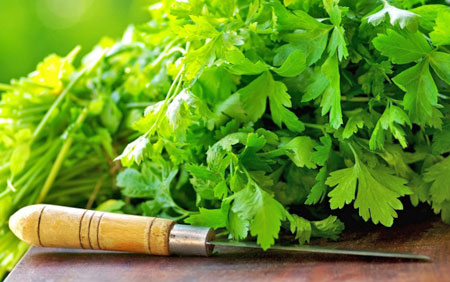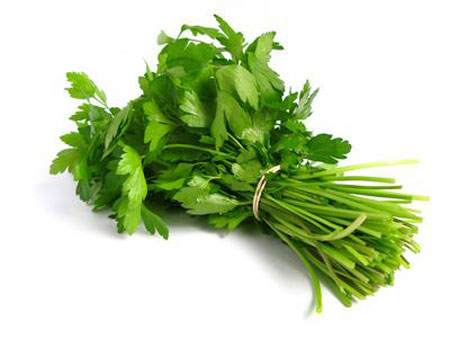|
If your restaurant plate is garnished with an herb, it’s probably parsley.
This herb is widely used and prized not only for it’s added flavor, but also for it’s health benefits. Once you understand medicinal and nutritional parsley health benefits, you won’t only eat your garnish, you may want to grow your own! And growing parsley is easy!
Parsley (Petroselnum crispum) is native to the Mediterranean region of the world. While its roots are in places like Southern Italy, Tunisia, and Algeria, it can now be found globally. Despite its current popularity, though, parsley has a somewhat dark past.
History of Parsley
Parsley wasn’t always so well-liked. As a matter of fact, the herb was known to strike people with fear.
According to Dr. May Berenbaum, head of the University of Illinois Entomology Department, it was associated with death and the devil. The Greeks said the herb first grew in the blood of a fertility king, Archemorus (forerunner of death). As a result, it was laid on their tombs and when someone was said to “need only parsley”, it meant they were near death.
The herb was so feared by the Greeks that an ancient Celt sent donkeys onto the battlefield adorned with parsley, and the Greek troops turned and fled.
Virgins who planted the herb were said to risk impregnation by the devil himself. The only planting of parsley was done on Good Friday. Any other day meant the gardener would risk certain curse.
But of course, this is just some of the foretold history. Fortunately, parsley’s relationship with fear disconnected over the centuries. Now, everyone has grown to love parsley.
Parsley Health Benefits
Parsley is of the family Apiaceae, along with carrots, celery, and other herbs like cumin, dill, lovage, angelica, and anise. It typically has longer stems and can grow to a few feet in height and diameter. The leaves are bright green and hairless.
The herb contains valuable volatile oils and flavonoids. The volatile oil known as myristicin has chemoprotective benefits which means it can neutralize cancer causing agents and has been shown to prevent tumor growth. Flavanoids like apigenin and luteolin found in parsley act as antioxidants to protect cells from oxidative damage and stress.
The herb also has other beneficial properties including:
Parsley is also a great source of vitamin C and beta-carotene (pro-vitamin A).
Some people put parsley on as high of a pedestal as kale in regards to health benefits. Just 1 tablespoon of parsley contains 61.5 micrograms of vitamin K (77% RDA), 5 milligrams of vitamin C (8% RDA), and 316 IUs of vitamin A (6% RDA).
Thanks to the herb’s magnificent nutritional profile, parsley health benefits range far and wide. Some of it’s healing effects include:
Growing Parsley
While you could wait until you get a little spring on your dinner plate, you’ll get far more benefits of this healing herb if you simply grow it yourself.
Like basil (sweet basil and holy basil), mint, and oregano, growing parsley is relatively easy. All it needs is some water, sunlight, good soil, and tender-loving care.
Parsley is best grown from seed (rather than a starter plant from the greenhouse). But, it has a notoriously slow germination period. Be patient, its coming. If you want a head start, soak your parsley seeds in a wet paper towel overnight before planting.
Choose a sunny spot for the parsley, whether in the garden or a large pot. It can even be grown indoors if it has a bright, warm area. Just know that it may be “leggier” than an outdoor plant due to the dimmer conditions. Parsley likes the sun but can cope with a little shade too. It also prefers moist soil, so water generously.
The seeds should be sowed about 1/8 to ¼ inch deep. When the plants are about 2 to 3 inches high, thin them so that they are 10 to 12 inches apart. Planting them apart ensures that they will have enough room to really flourish.
Harvest your parsley by snipping it off close to the ground. Choose those stems that are on the outside of the plant. This will encourage a fuller, healthier plant. Using ParsleyThe best way to use parsley is when it’s fresh. It can be dried or frozen but loses much of its flavor that way.
The easiest way to receive parsley health benefits is by simply eating it. This is especially true for digestive ailments or bad breath. Simply chew on a few sprigs of parsley and you should see quick benefits.
Alternately, you can always make a tea, using 2 tablespoons of fresh parsley per 2 cups of water. Steep for several minutes before straining ,and enjoy. You can also add parsley to your foods for the nutritional perks. It makes a perfect addition to green smoothies too, upping their detoxification power.
Parsley is just one of the many herbs you can grow at home in your yard or a sunroom. In addition to being a powerful healer, it’s a great culinary tool.
Additional Sources
May 9, 2011
from
NewsBureauUniversityMissouri
Website
In a new study, a University of Missouri researcher has found that a compound in parsley and other plant products, including fruits and nuts, can stop certain breast cancer tumor cells from multiplying and growing.
The study was published recently in
Cancer Prevention Research.
Parsley is usually used as a decorative accent to a scrumptious meal, but don't set it aside just yet. In a new study, a University of Missouri researcher has found that a compound in parsley and other plant products, including fruits and nuts, can stop certain breast cancer tumor cells from multiplying and growing.
(Credit: © Furret /
Fotolia) In his study, Salman Hyder, the Zalk Endowed Professor in Tumor Angiogenesis and professor of biomedical sciences in the College of Veterinary Medicine and the Dalton Cardiovascular Research Center, exposed rats with a certain type of breast cancer to apigenin, a common compound found in parsley and other plant products.
The rats that were exposed to the apigenin developed fewer tumors and experienced significant delays in tumor formation compared to those rats that were not exposed to apigenin.
Hyder believes this finding could impact women who are taking certain hormone replacement therapies.
When tumor cells develop in the breast in response to MPA, they encourage new blood vessels to form within tumors.
The blood vessels then supply needed
nutrients for the tumors to grow and multiply. Hyder found that
apigenin blocked new blood vessel formation, thereby delaying, and
sometimes stopping, the development of the tumors. Hyder also found
that the compound reduced the overall number of tumors. However,
while apigenin did delay tumor growth, it did not stop the initial
formation of cancer cells within the breast.
However, apigenin is not absorbed efficiently into the bloodstream, so scientists are unsure of how much can or should be ingested.
The next phrase of studies should
include human clinical trials to determine the appropriate dosage
amount, Hyder said. He believes further study on humans is necessary
to address any health and safety issues that might exist.
from
NaturalNews Website
The Greeks made crowns of parsley to
bestow upon their sports champions. It was used for the Hebrew
celebration of Passover as a sign of rebirth in the spring. The
Romans used it to deodorize corpses before funerals.
Additionally, parsley is rich in
flavonoids-including apiin, apigenin, crisoeriol, and luteolin that
have strong anti-oxidant properties.
And, it contains carotenoid
anti-oxidants lutein and zeaxanthin which enhance eye function and
help the body neutralize damage from UV radiation.
Chlorophyll helps to alkalize the body,
purify blood, and form new red blood cells. In addition, the
chlorophyll and flavonoids in parsley help to enhance cellular
glutathione formation. Higher levels of cellular glutathione allow
the body to detoxify and heal more effectively.
This is particularly useful
for anyone with poor circulation, swelling, cellulite, and other
cardiovascular problems.
This is one of the best aids for
neutralizing acid reflux, gas and bloating.
Most people smile and ask sheepishly,
If it is certified organic parsley, then the answer is "yes."
Parsley leaf is loaded with antioxidants
and is a fantastic diuretic. The herb is a wonderful kidney aid,
helping to get rid of kidney stones and edema (swelling), as well as
healing any urinary tract infection or inflammation. Parsley root is
high in calcium, iron, and B complex vitamins.
Fourteen people ate a restricted diet for two weeks which was high in parsley, but low in other foods containing flavones and other natural sources of antioxidants. Urinary excretion of the flavone apigenin was measured before and during the ingestion of parsley.
Apigenin levels were noticeably higher when parsley was added to the diet. The researchers noted that when the subjects were on the restricted diet, their oxidative stress markers rose.
However, when the people added parsley
during the second week of study, the parsley was able to reverse
these numbers somewhat.
Rats were given parsley seed tea to drink. Over a twenty-four hour period, the rats had a marked increase in urinary volume. The scientists believed that parsley works as a diuretic due to a mechanism in the herb which blocks the re-absorption of sodium and potassium.
This causes more water to flow via
osmosis, and hence, a greater urinary volume.
Dr. Christopher used parsley for water retention (edema), and suggested parsley root tea for stiff fingers and other joint issues. He said gallstones could be removed by drinking a pint of fresh parsley tea every day. The herb is also calming to the nerves and adrenal glands.
Dr. Christopher recommended at least two
quarts of strong parsley tea per day for these issues, or even up to
a cup of tea every hour. To make fresh parsley tea, add a large
handful of parsley to a pint of boiling water. Cover, steep, and
drink the tea throughout the day.
No more than an ounce or two of parsley
juice should be taken at any one time.
|


